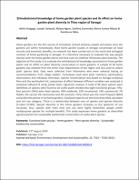| dc.contributor.author | Naigaga, Hellen | |
| dc.contributor.author | Ssekandi, Joseph | |
| dc.contributor.author | Ngom, Ablaye | |
| dc.contributor.author | Sseremba, Godfrey | |
| dc.contributor.author | Mbaye, Mame Samba | |
| dc.contributor.author | Noba, Kandioura | |
| dc.date.accessioned | 2021-10-29T12:58:27Z | |
| dc.date.available | 2021-10-29T12:58:27Z | |
| dc.date.issued | 2020-08-13 | |
| dc.identifier.issn | https://www.springer.com/journal/10668 | |
| dc.identifier.uri | http://hdl.handle.net/20.500.12280/2851 | |
| dc.description.abstract | Home gardens are the frst source of immediate contact between people and plants since
the gardens are within homesteads. Most home garden studies in Senegal concentrate on
food security and economic benefts; no research has been carried out on the social and
ecological contexts of home gardening in Senegal. It is therefore necessary to evaluate the
way people interact with the home garden plants and how such an interface infuences plant
diversity. The objective of this study is to evaluate the ethnobotanical knowledge associated to home garden plants and its efect on plant diversity conservation in home gardens.
A sample of 30 home gardens was selected from the three main departments of the region
and was used to collect plant species data. Data were collected from informants who were
selected basing on recommendations from village leaders. Techniques used were plant
inventory, participatory observations and individual interviews. Species nomenclature was
based on Senegal analytical fora and the world plant list; comparison of efect between different variables was analyzed in analytical software R using simple linear regression analysis. A total of 96 plant species were identifed; all species were found to be useful plants
divided into eight functional groups. Fifty-four percent (54%) were food species, 40%
medicinal, 32% ornamental, 14% commercial, 7% fodder, 4% sacred, 4% ceremonial and
3% cosmetic. Citrus limon was the most frequent (80%) and preferred species in the home
gardens. Food plant species are the most diversifed, abundant and rich use category. There
is a relationship between uses of species and species diversity (P value<0.001). Species
diversity in the home gardens increases as the spectrum of use increases; thus, species with
more than one use were highly diversifed; people prefer multipurpose species for multiple
benefts. This study expresses home gardens as diversifed agroecosystems for sustainable
biodiversity conservation of useful plant species. | en_US |
| dc.language.iso | en | en_US |
| dc.publisher | Springer Link | en_US |
| dc.relation.ispartofseries | Environment, Development and Sustainability;23, 7524 – 7536 (2021) | |
| dc.subject | Functional plant groups | en_US |
| dc.subject | Home gardens | en_US |
| dc.subject | Plant species diversity | en_US |
| dc.subject | Sustainable biodiversity conservation | en_US |
| dc.title | Ethnobotanical Knowledge of Home Garden Plant Species and its Effect on Home Garden Plant Diversity in Thies Region of Senegal | en_US |
| dc.type | Article | en_US |


